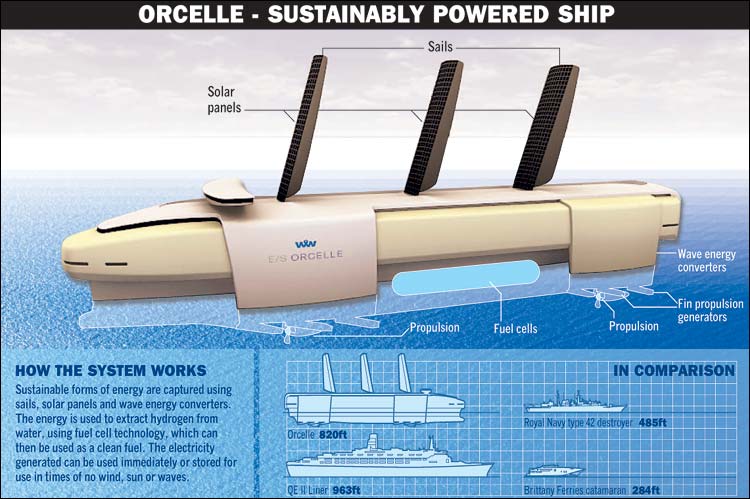- It is the ship of the future - powered by the sun, wind
and waves. The futuristic vessel has no conventional engines, uses no fossil
fuels and releases no harmful emissions into the atmosphere or pollution
into the sea.
-
- The first ship to use the technology will be a cargo
vessel that will transport up to 10,000 cars from Britain to Australia,
New Zealand and other countries. If successful, it will be used on passenger
ferries and cruise ships.
-
- The wave energy is harnessed by 12 dolphin-like fins
on the ship's hull, while sun and wind energy is collected by three giant,
rigid, fin-like sails covered in solar panels.
-
- The sails and fins will also help the ship to cruise
at a speed of 15 knots and stability will be provided by the pentamaran
hull - a slim monohull that will have two smaller support hulls, known
as sponsons, on each side.
-
- Once harnessed the sun, wind and wave energy will be
combined with hydrogen and stored in fuel cells.
-
- A spokesman for Wallenius Wilhelmson, the ship's Scandinavian
designers who have a British headquarters in Southampton, said: "This
will be the first truly environmentally friendly ship, protecting the atmosphere
and marine species. It will transform ocean transport."
-
- The international shipping company transports 160,000
cars a year, including Jaguars, Land Rovers and BMWs, from Southampton
to Australia, New Zealand and other countries.
-
- The vessel will include a cargo deck the size of 14 football
pitches. It will be able to carry up 10,000 cars in emission-free conditions.
-
- At 820ft long it will be shorter than the Queen Mary
2 (1,132ft) and the QE2 (963ft), but more than three times the length of
a Boeing 747 jumbo jet (232ft).
-
- The ship is called the E/S Orcelle after the orcelle
dolphin - the French word for the Irrawaddy dolphin, one of the world's
most critically endangered species. The E/S stands for "environmentally
sound ship".
-
- The ship's design means that it will not need to carry
ballast water, used to stabilise traditional vessels. The collection and
disposal of ballast water has worried marine conservationists for years.
-
- Many fragile species are collected inadvertently when
a ship takes thousands of tons of water from the sea for ballast.
-
- When the water is emptied back into the ocean, often
thousands of miles away, many species are dumped in alien environments
that threaten their survival. The company, which has about 60 modern vessels
that carry 17 million vehicles a year by sea, will unveil a model of the
E/S Orcelle at Expo, the world trade fair, in Aichi, Japan, next month.
-
- Nils Dyvik, the company's chief executive, said that
a ship with some of the Orcelle's "environmentally friendly characteristics"
could be launched within five years, but said that the "complete version"
might not be crossing the oceans until 2025.
-
- The cost of the futuristic vessel is not known, but Mr
Dyvik said that he expected that it would be more expensive than a conventional
cargo ship, which costs up to £46 million. "The cost is likely
to come down, however, as the technology gets cheaper," he added.
-
- Mr Dyvik said that the E/S Orcelle was the future of
ocean transport. "It represents the achievable goal of building a
zero-emission cargo ship," he said. "The shipping industry has
to play its part in protecting the environment and we are determined to
be at the forefront of efforts to help to protect marine life on the high
seas."
-
- © Copyright of Telegraph Group Limited 2005.
-
- http://www.telegraph.co.uk/news/.html
|

